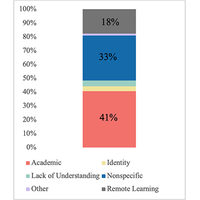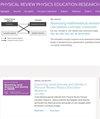Exploratory analysis of students’ open-ended responses describing their perception of course inclusivity in an introductory physics course
IF 3.6
2区 教育学
Q1 EDUCATION & EDUCATIONAL RESEARCH
Physical Review Physics Education Research
Pub Date : 2024-08-26
DOI:10.1103/physrevphyseducres.20.020112
引用次数: 0
Abstract
In this exploratory study, we examined students’ perceptions of inclusion in a calculus-based, introductory physics 1 course for science and engineering majors. This course, offered at a large R1 institution in the United States, was conducted remotely due to the COVID-19 pandemic. Via a survey given at the end of the semester, students rated their course inclusion and provided open-text explanations for their ratings. On average, students rated the course as moderately inclusive. Using inductive qualitative content analysis, six categories emerged: academic, identity, lack of understanding, nonspecific, other, and remote learning. The top three categories were academic (41%), nonspecific (33%), and remote learning (18%). The remote learning category included phrases containing remote learning, Zoom, or COVID-19, along with a second idea explaining the student’s level of inclusion, leading to remote learning subcategories. These subcategories were similar to the other primary categories and the academic subcategories. Many students cited academic reasons for their inclusivity scores, including course structure, teaching practices, instructor-student interaction, student-student interaction, and overall course environment. Importantly, many of these factors are within the instructor’s influence. Chi-square tests indicated that students perceiving high inclusion emphasized academic factors, while those feeling low inclusion focused on the remote learning aspect of the course. Overall, our findings suggest that instructors can significantly influence students’ perceptions of inclusion through various teaching strategies, interactions between instructors and peers, and a welcoming environment. These insights contribute to the ongoing discussion about creating inclusive classrooms by incorporating student perspectives.

探索性分析学生对物理入门课程包容性的开放式回答
在这项探索性研究中,我们考察了学生对理工科专业微积分入门物理 1 课程中的包容性的看法。这门课程在美国一所大型 R1 院校开设,由于 COVID-19 大流行而采用远程授课。通过学期末的调查,学生们对课程的包容性进行了评分,并对他们的评分提供了开放文本解释。平均而言,学生认为课程的包容性适中。通过归纳定性内容分析,得出了六个类别:学术、身份、缺乏了解、非特定、其他和远程学习。排在前三位的类别是学术(41%)、非特定(33%)和远程学习(18%)。远程学习类别包括包含远程学习、Zoom 或 COVID-19 的短语,以及解释学生融入程度的第二个想法,从而形成远程学习子类别。这些子类别与其他主要类别和学术子类别相似。许多学生提到了他们的包容性得分的学术原因,包括课程结构、教学实践、教师与学生的互动、学生与学生的互动以及整体课程环境。重要的是,这些因素中有许多都在教师的影响范围之内。卡方检验表明,认为包容性高的学生强调学术因素,而认为包容性低的学生则关注课程的远程学习方面。总之,我们的研究结果表明,教师可以通过各种教学策略、教师与同学之间的互动以及友好的环境,极大地影响学生的融入感。这些见解有助于人们继续讨论通过纳入学生的观点来创建全纳课堂的问题。
本文章由计算机程序翻译,如有差异,请以英文原文为准。
求助全文
约1分钟内获得全文
求助全文
来源期刊

Physical Review Physics Education Research
Social Sciences-Education
CiteScore
5.70
自引率
41.90%
发文量
84
审稿时长
32 weeks
期刊介绍:
PRPER covers all educational levels, from elementary through graduate education. All topics in experimental and theoretical physics education research are accepted, including, but not limited to:
Educational policy
Instructional strategies, and materials development
Research methodology
Epistemology, attitudes, and beliefs
Learning environment
Scientific reasoning and problem solving
Diversity and inclusion
Learning theory
Student participation
Faculty and teacher professional development
 求助内容:
求助内容: 应助结果提醒方式:
应助结果提醒方式:


